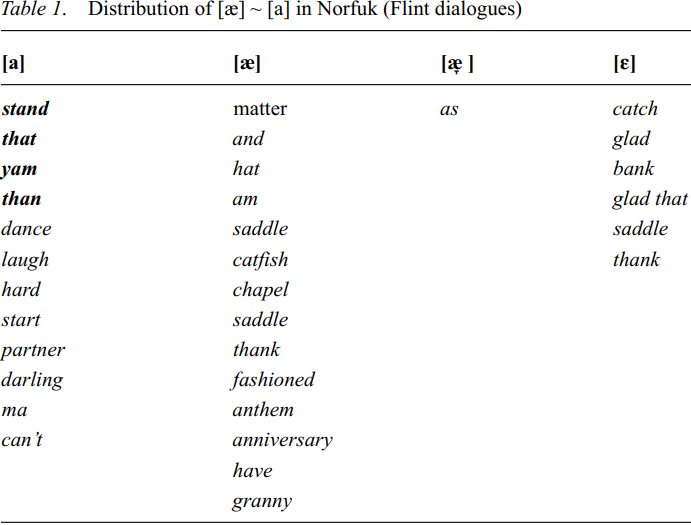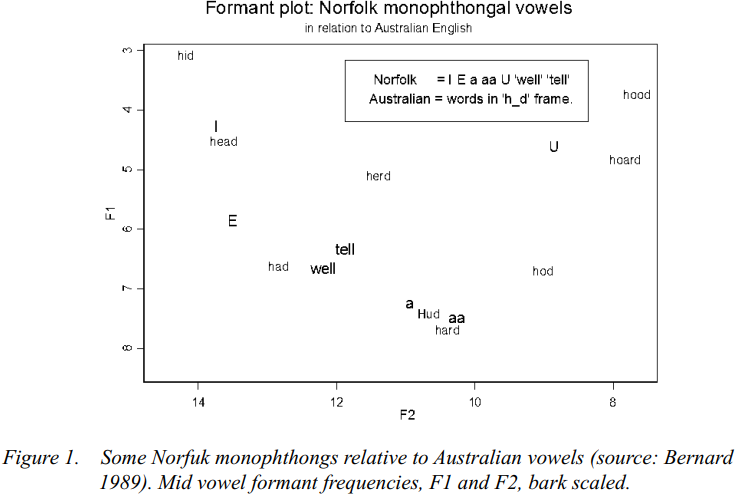


 Grammar
Grammar
 Tenses
Tenses
 Present
Present
 Past
Past
 Future
Future
 Parts Of Speech
Parts Of Speech
 Nouns
Nouns
 Verbs
Verbs
 Adverbs
Adverbs
 Adjectives
Adjectives
 Pronouns
Pronouns
 Pre Position
Pre Position
 Preposition by function
Preposition by function 
 Preposition by construction
Preposition by construction
 Conjunctions
Conjunctions
 Interjections
Interjections
 Grammar Rules
Grammar Rules
 Linguistics
Linguistics
 Semantics
Semantics
 Pragmatics
Pragmatics
 Reading Comprehension
Reading Comprehension|
Read More
Date: 2024-03-21
Date: 2024-03-20
Date: 2024-03-29
|
To provide an initial characterization of the Norfolk vowel space, and in order to reference points for inter-dialect comparisons, the single target, lax (short) vowels, ([ɪ], [a], [ε], [ʊ]) and long [a:], were plotted for each speaker, within the vowel space of Australian English. The formant values for the Norfuk vowels represent average measurements (centroids) obtained from 5−10 tokens per speaker. The formant values were statistically normalized to take account of differences in speakers’ vocal tract size and were plotted using the Bark scale frequency transformation. The Australian English reference vowels represent centroid values of the cultivated, general, and broad varieties reported by Bernard (1989). The Norfuk formant measurements were made from stressed lexical items, that occurred in discourse where no vowel reduction was evident. Nevertheless, some shrinkage of the vowel space in relation to Bernard’s measurements is to be expected, because his data were obtained from citation forms spoken in isolation and not culled from connected speech.
The somewhat lower and centralized target positions for Norfuk high vowels [ɪ] and [ʊ] are likely due to articulatory undershoot in connected speech compared with the Australian English citation forms. However, the lower target position of Norfuk [ε] compared with its Australian English counterpart is significant. One notable instance of allophonic variation was found among these lax vowels. The short front vowel [ε] lowers to [æ] before /l/. Although sometimes found as a phonetic tendency among speakers of Australian English, it seems to be more strongly marked in Norfolk vernacular, falling clearly within the vowel quality domain of [æ]. Flint suggests that there is no native contrast between [æ] and [a] in the Norfuk and that [æ] forms derive from the influence of Australian English through standard Norfolk English (the H variety). However, the data from our two speakers appear to suggest otherwise. Both [a] and [æ] forms are found in lexical items of English origin, but their lexical distribution is different from that of Australian English. In Table 1, bold print indicates [Q] pronunciation in Australian English.


If the standard account of the historical split of Middle English short /a/ is correct, these forms may provide a clue to the regional English dialect which had a dominant influence in the formation of the original Norfolk Island contact creole. The original split took place when ME /a/ lengthened (and in some dialects retracted) before voiceless anterior fricatives (laugh, path, grass). Subsequently, and incompletely, the change spread to nasal obstruent clusters (dance, grant, demand), resulting in the well-known regional and lexical variability found in these forms today. Although the data here is limited, it suggests a southern English dialect influence in the formation of Norfuk vernacular.
|
|
|
|
لصحة القلب والأمعاء.. 8 أطعمة لا غنى عنها
|
|
|
|
|
|
|
حل سحري لخلايا البيروفسكايت الشمسية.. يرفع كفاءتها إلى 26%
|
|
|
|
|
|
|
جامعة الكفيل تحتفي بذكرى ولادة الإمام محمد الجواد (عليه السلام)
|
|
|